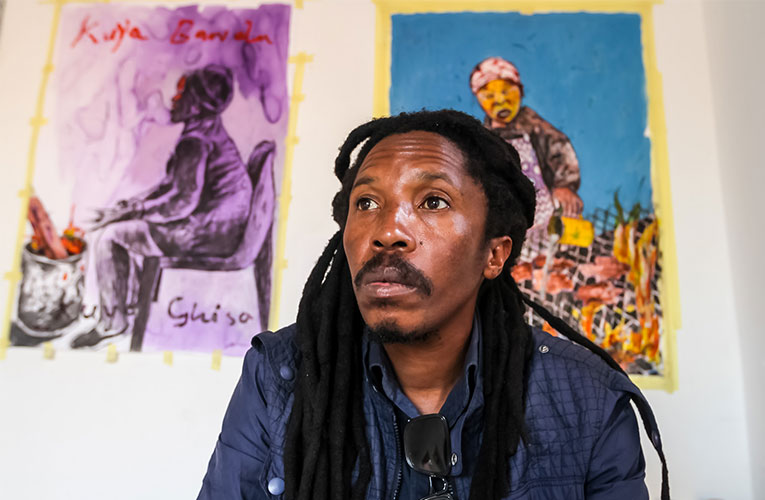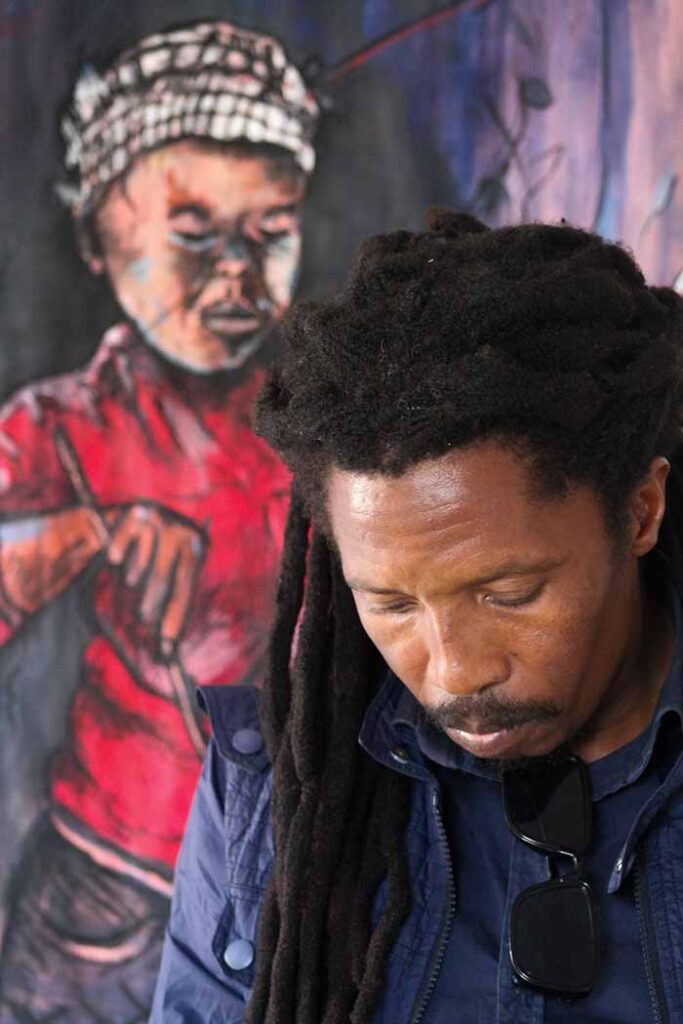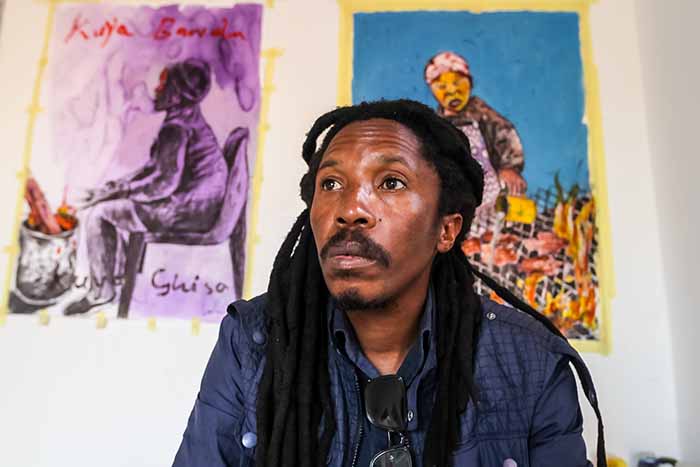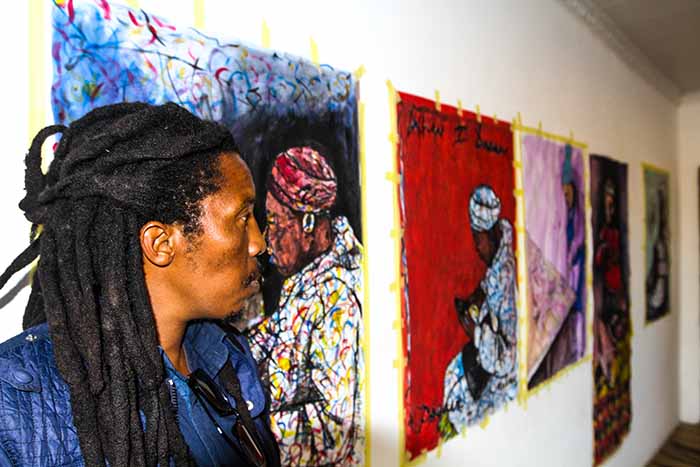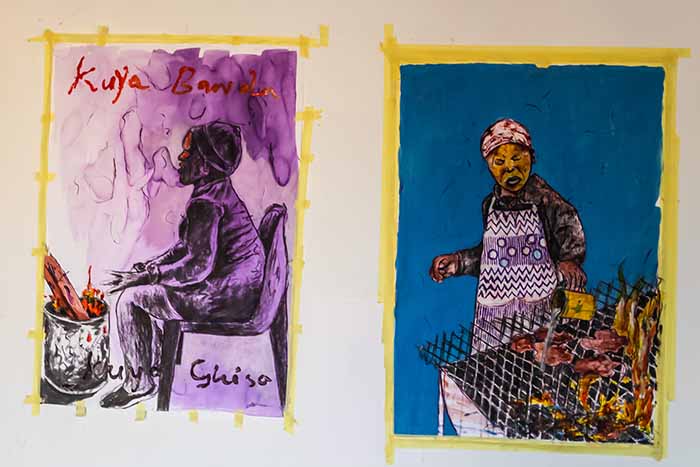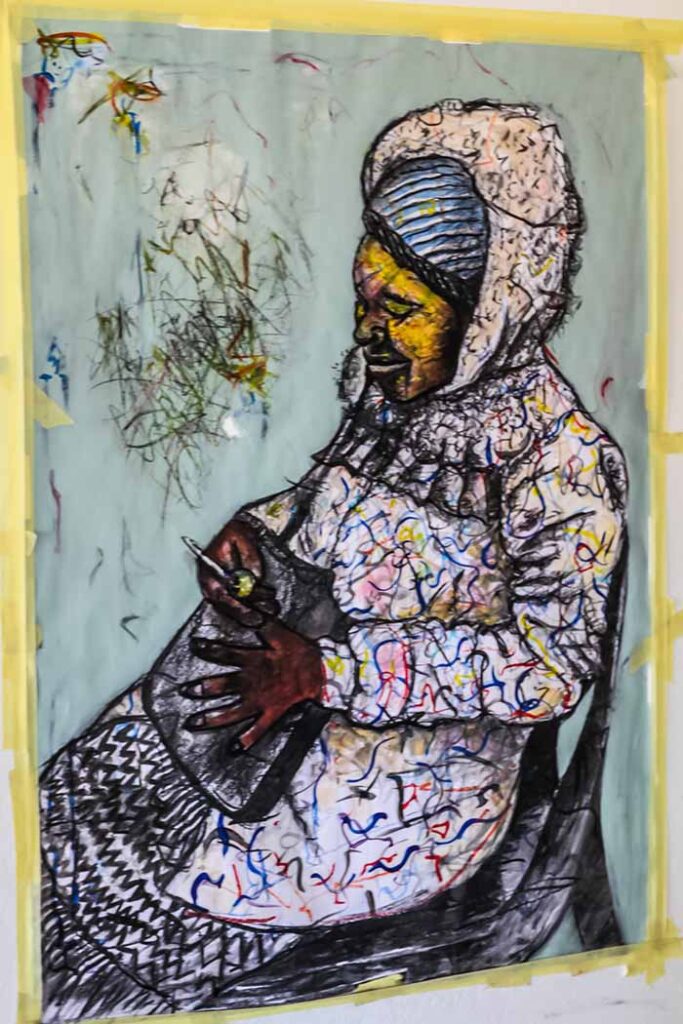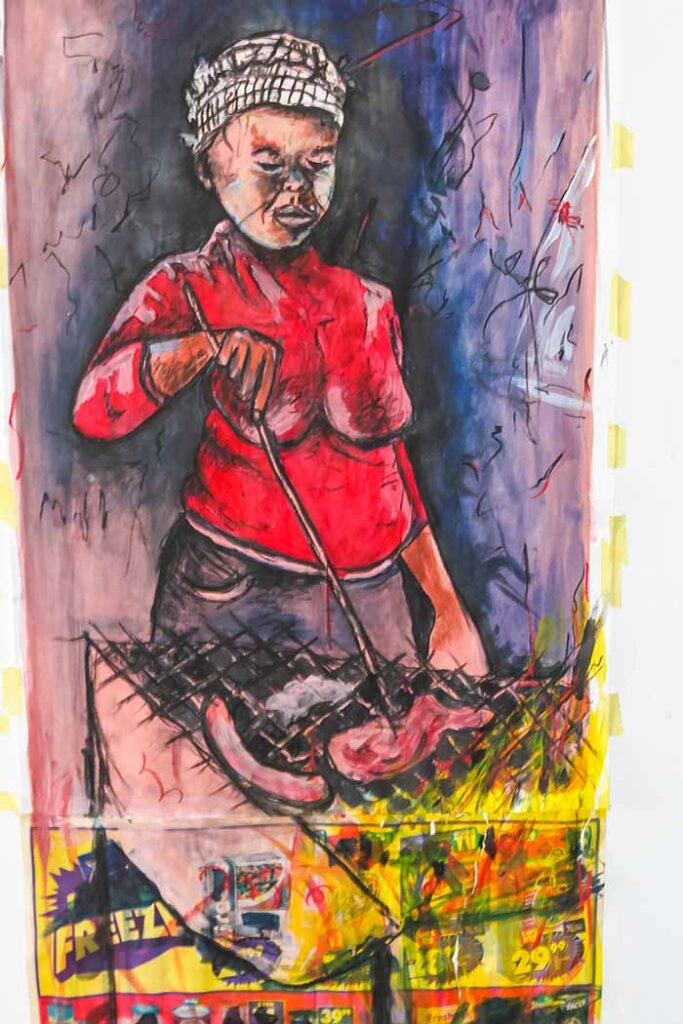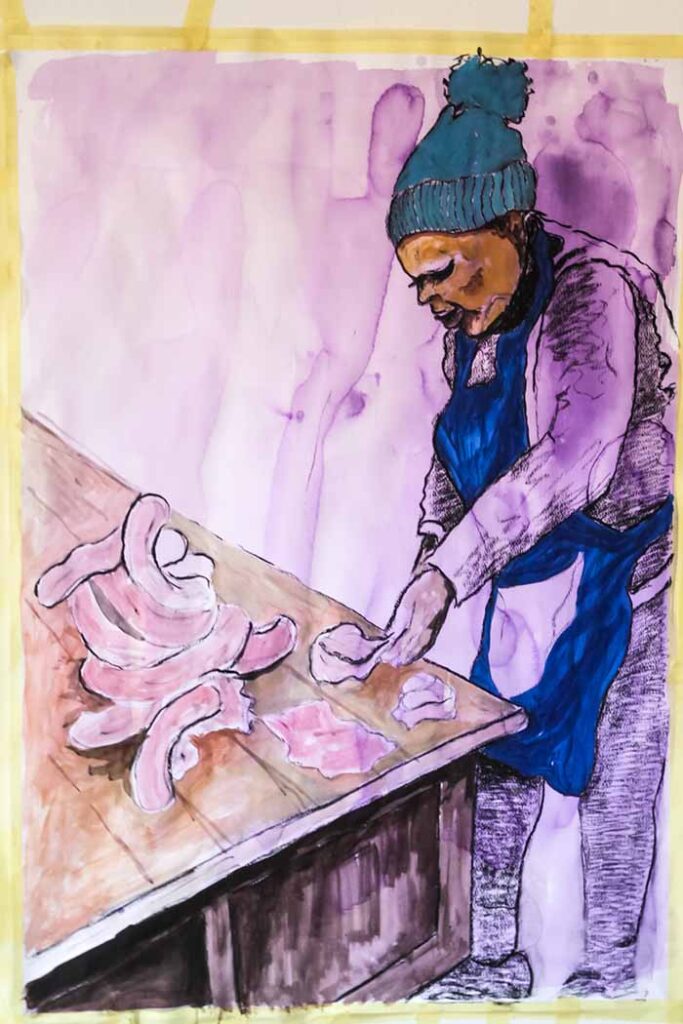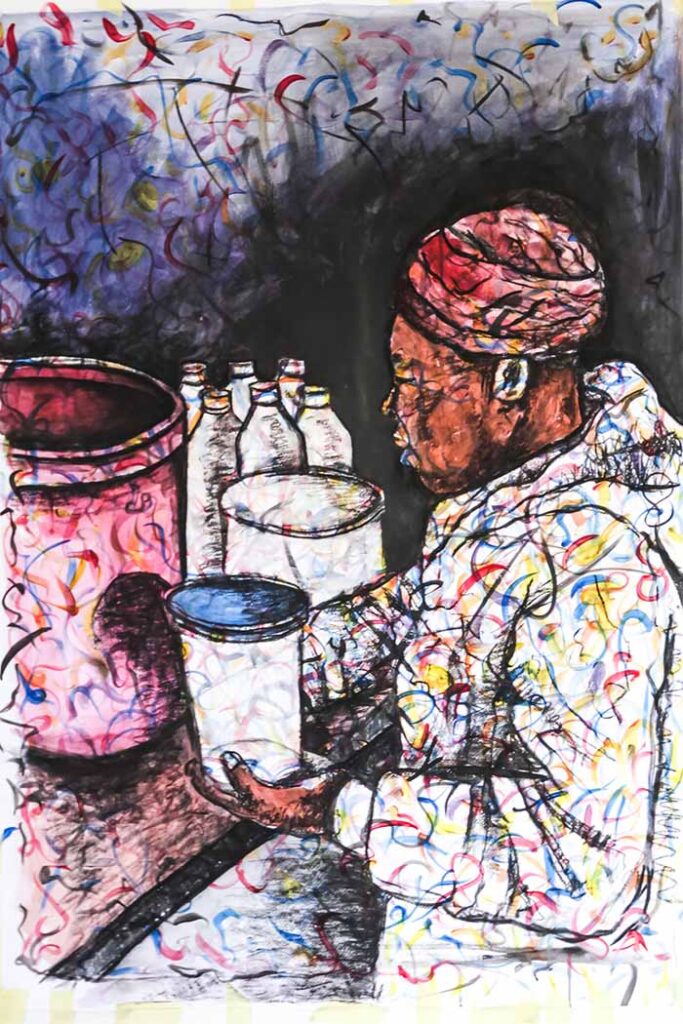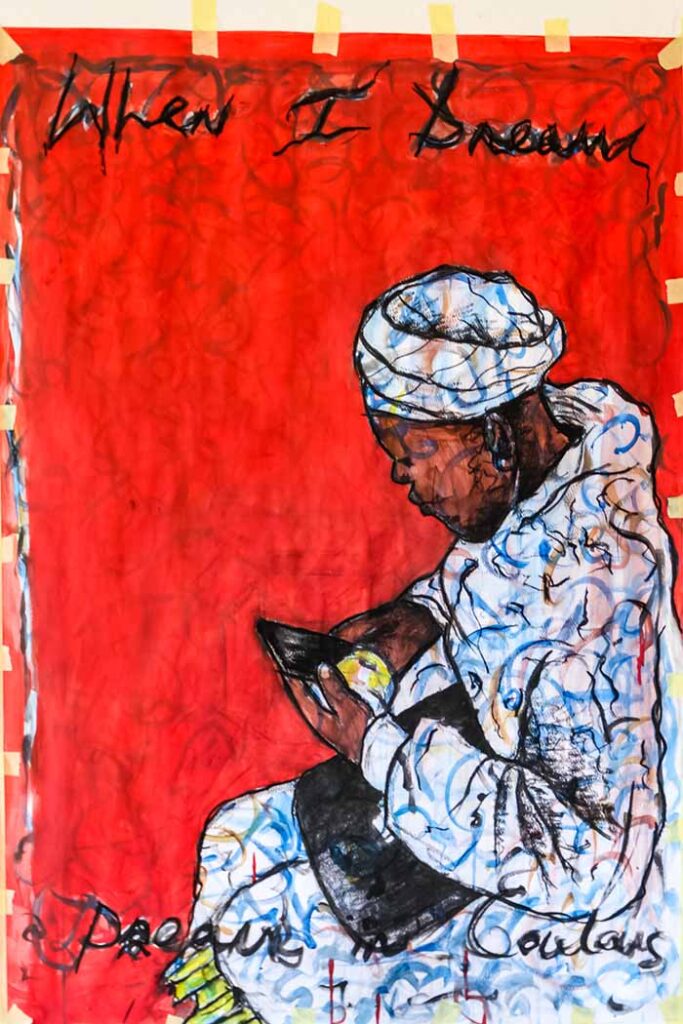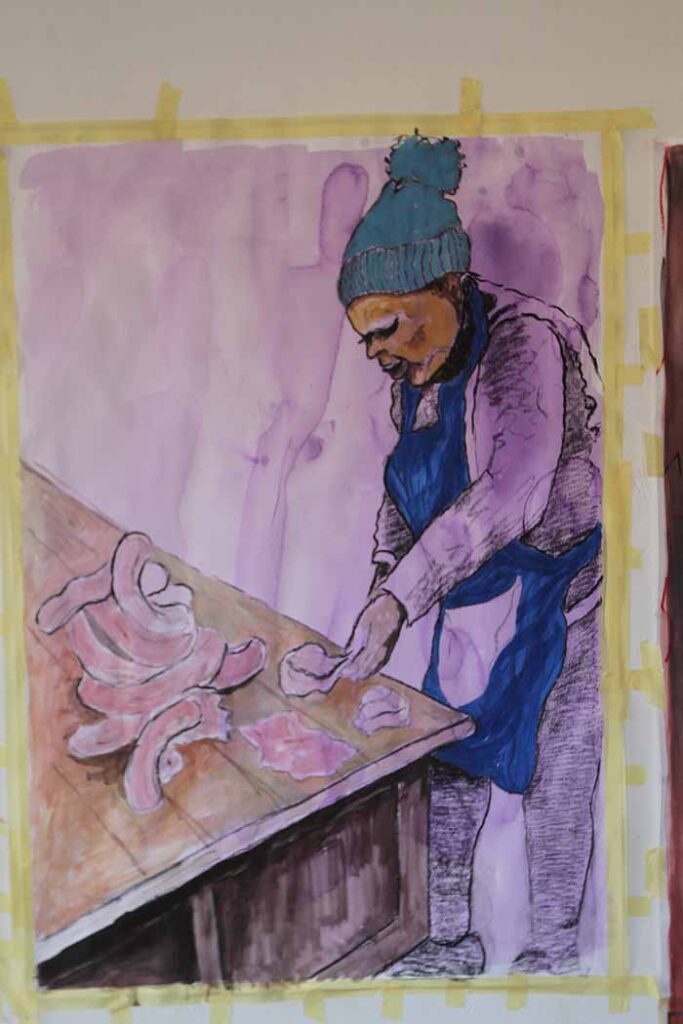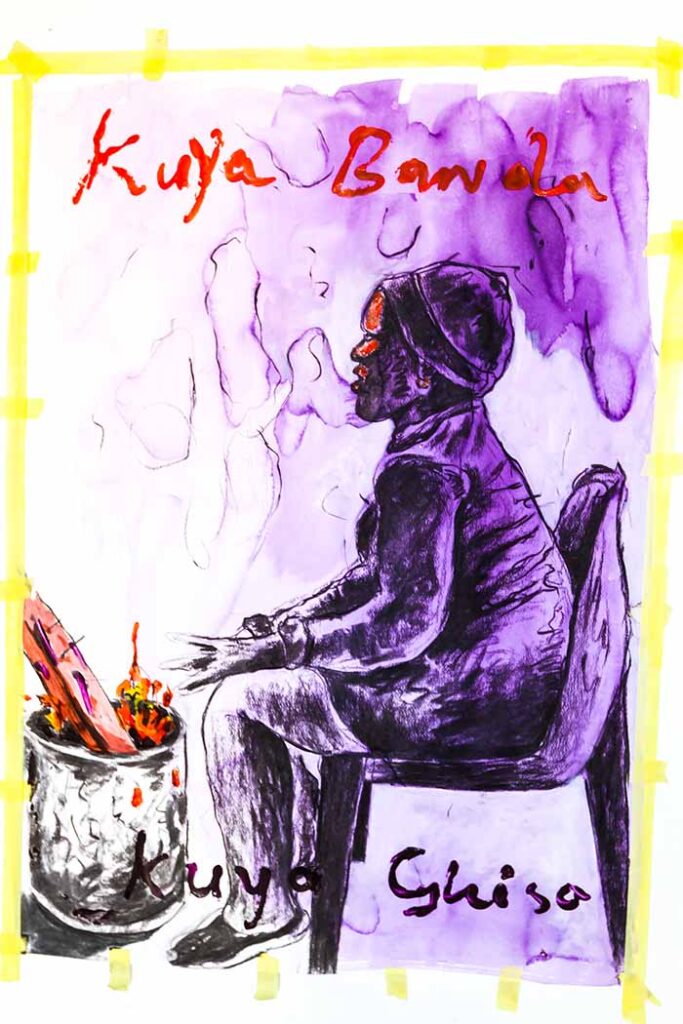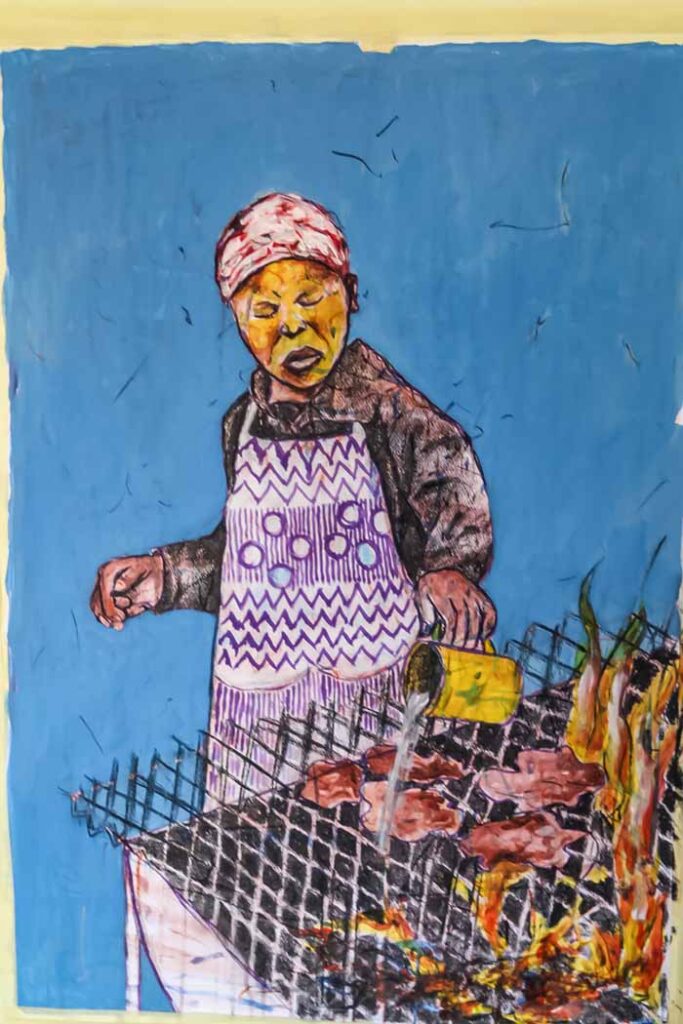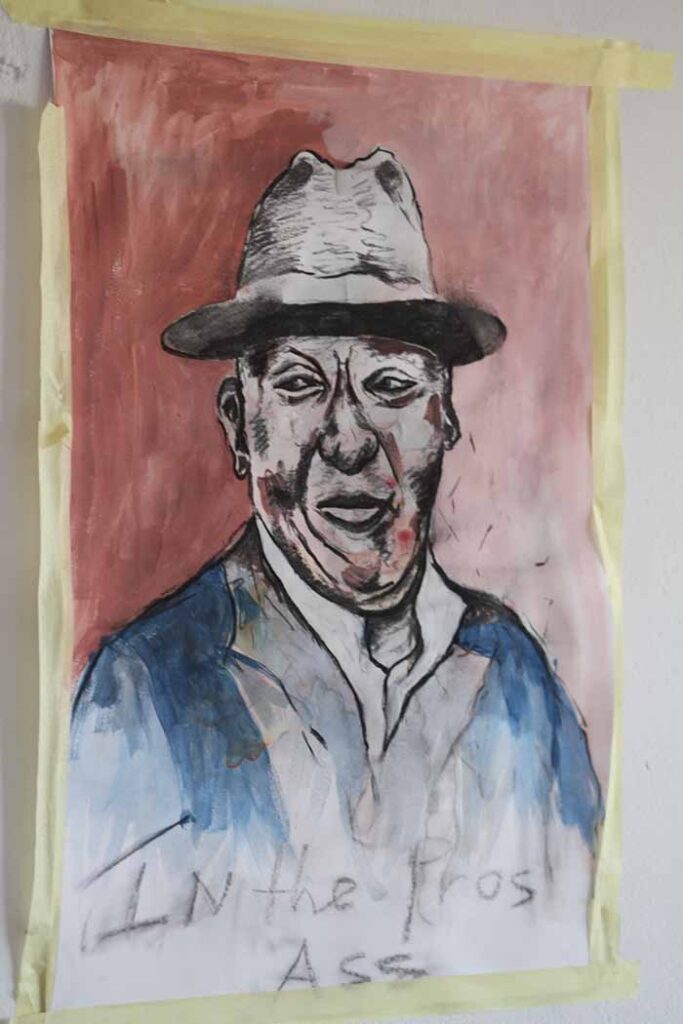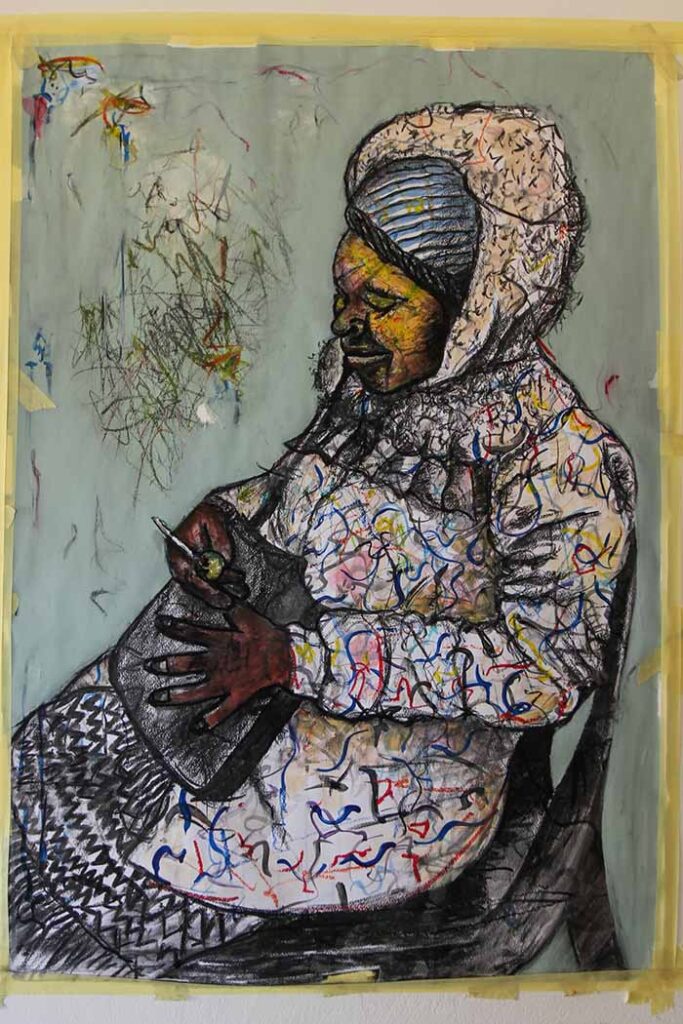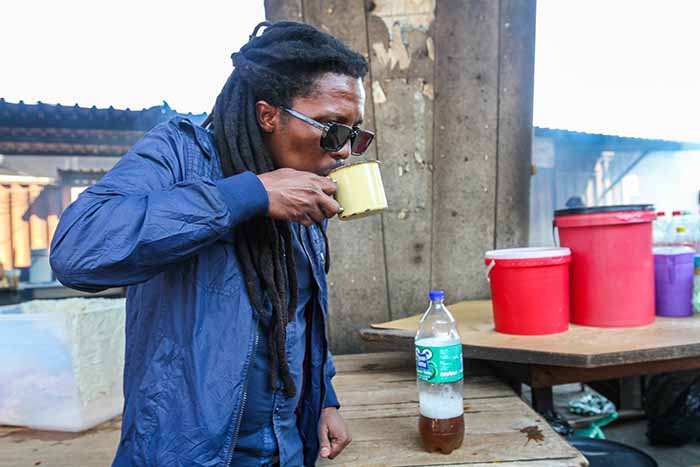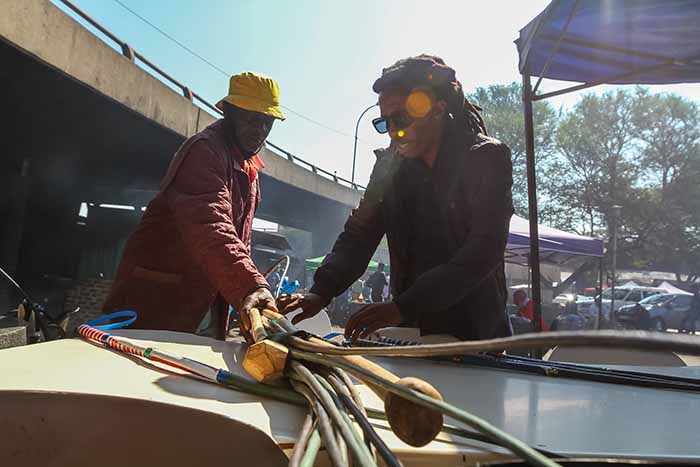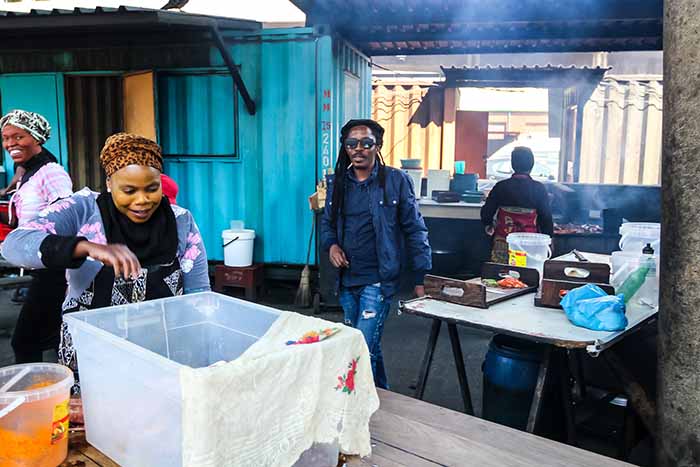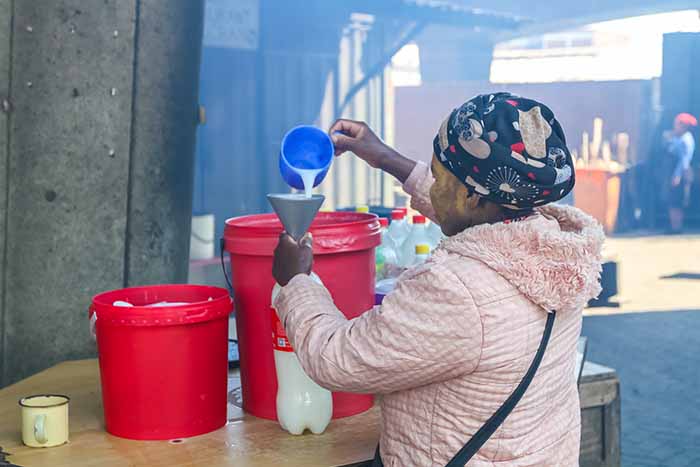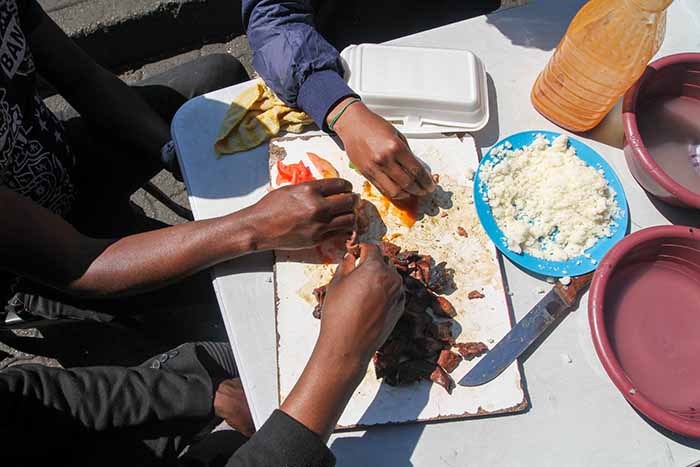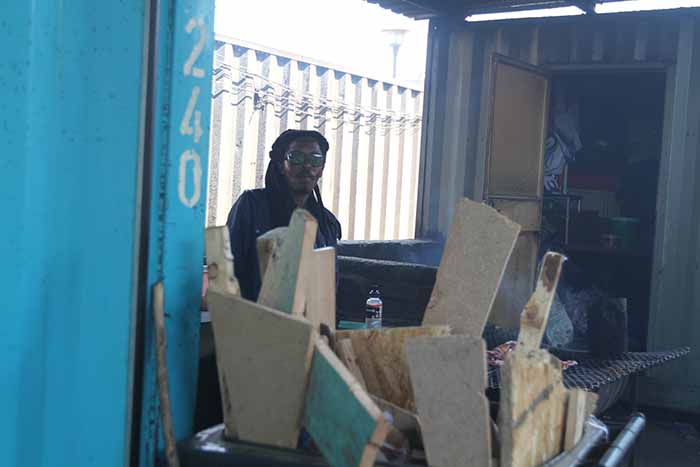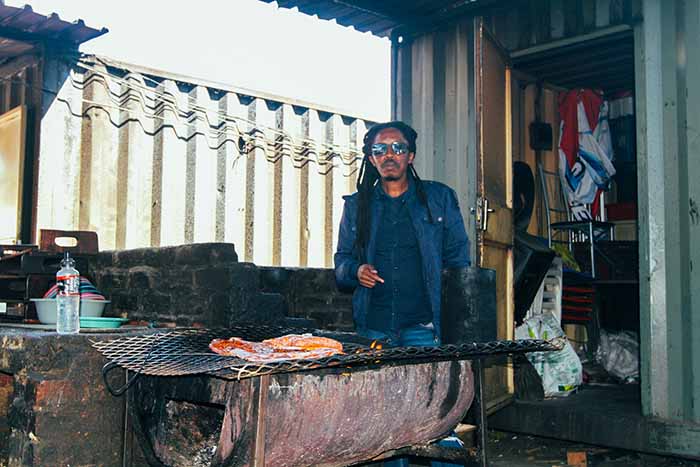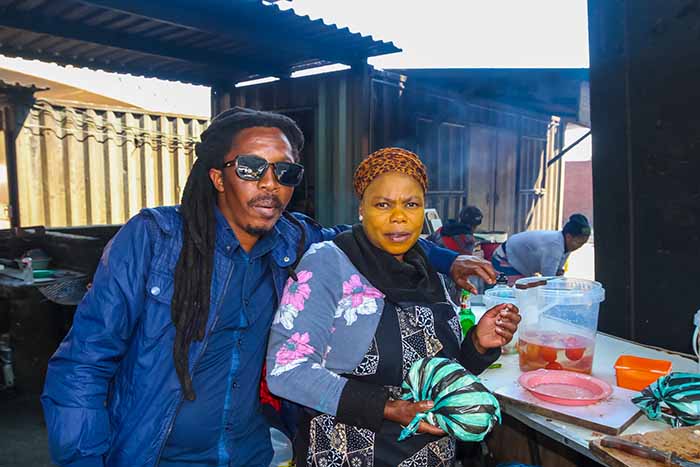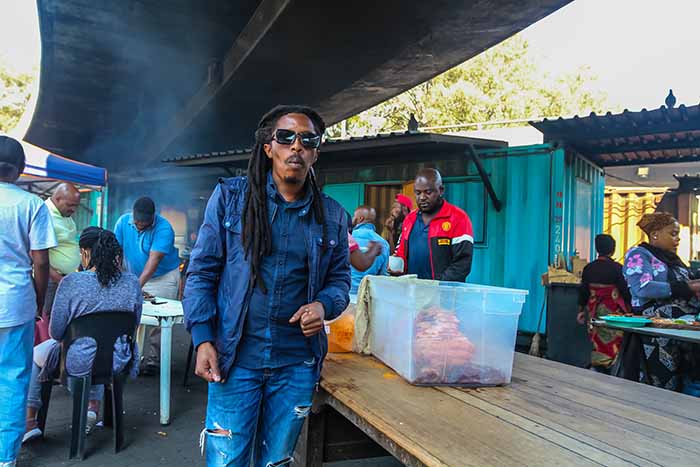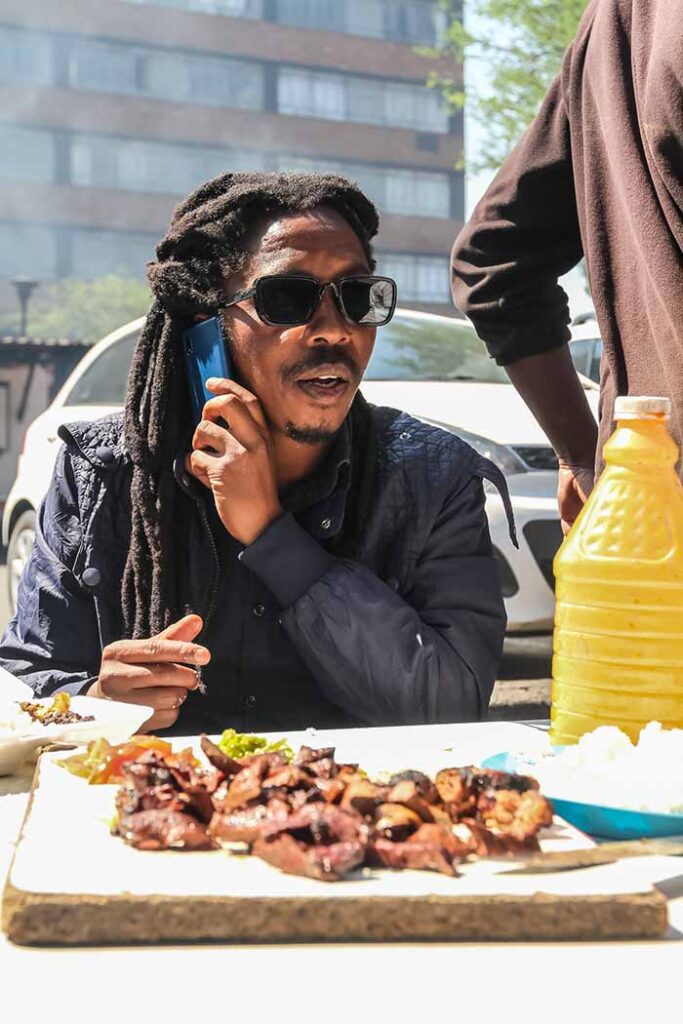Visual artist Happy Dhlame painting KwaMai Mai
The series along with other works from other South African artists is headed for Miami and Art Basel
By Edward Tsumele, CITYLIFE/ARTS Editor

The gentrified Johannesburg area East of Maboneng, once streaming with tourists from Germany, the UK, France, Switzerland, the Netherlands, and North America, is again a hive of activity. However, this time it is a young local population visiting. This fun loving local population has now become the engine of this local economy.
To feel the vibe, you have to visit the bars and pubs, hear the music, listen to DJs playing the popular South African music genre known as Amapiano, the flavour of the moment, which is fast spreading its tentacles internationally as well.
If you are not familiar with the history of the general area around Jeppe, where Maboneng is situated, you may wrongly think that life starts and ends in Maboneng, without understanding that only two streets away from Maboneng, another place, only a few square metres in size, is equally full of life.
The difference is that this area is full of history and carries a rich cultural heritage and value.
It is here that you will come to understand the impact of several generations of migration from the rural hinterland of South Africa to the urban areas, especially from the 19th century right up to the 21st century. In this case, it is a migration of several generations from rural KwaZulu-Natal to Johannesburg. The area which hosts two well known hostels, Jeppe Hostel and George Goch Hostel, where historically male migrant workers from KwaZulu-Natal working mainly in the mines around the Reef were once housed, has an off shoot of a cultural melting pot. That off shoot is a bustling market place known as Kwa Mai Mai, known for being a market place for those looking for an alternative to Western medicine, a traditional concoction known as muti or herbs, as remedies for various ailments.
But Kwa-Mai Mai is more than a muti place, as it also has a section where for R50 one will get a generous portion of braaied meat served with pap that is prepared in a traditional Zulu way. What you get for paying relatively little could easily give conventional restaurants a run for their money.
But again, Kwa Mai Mai is more than a muti and braaied meat market place, even though these are part of the experience at this culturally vibrant place. Kwa Mai Mai is a cultural experience, an oasis of Zulu culture and tradition almost as practised in rural KwaZulu-Natal. The difference here is that these traditions that are quite often explicitly expressed here in relation to language, dress sense, mannerism and through other nuanced Zulu-cultural markers have managed to exist within the context of a dynamic ally evolving cosmopolitan city culture.
At Kwa-Mai Mai you will witness mainly women running their ‘mini-kitchens,’ essentially an array of barely dressed tables and with chairs, well arranged by their individual owners. There also is a braai stand next to each individual table, where customers’ meat is braaied as you wait for your turn to eat at the table.
But one thing you will notice about these women entrepreneurs is that they are proudly Zulu and they do not shy away from expressing their traditions by tribal marks on their faces, such as the red ochre they put on their faces, an equivalent of the Western make-up, besides the traditional clothes they adorn their bodies with. By watching these women do their brisk business, seemingly oblivious to the cosmopolitan cityscape surrounding them and its ever evolving urban culture, you would be forgiven to think that you are in deep rural Kwa-Zulu-Natal, and not deep in the belly of urban Johannesburg during this century of Artificial Intelligence and Zoom business meetings .
The government often struggles looking for a model that would empower women entrepreneurs. In fact the tip is, government officials do not have to look further than KwaMai Mai. These women are empowered and the model is working for them as it becomes clear that those at the heart of business activities and entrepreneurship at KwaMai Mai are women.
It is this rich cultural heritage that is so explicitly expressed in Mai Mai by mainly predominantly female entrepreneurs which has attracted the meticulous and painterly eye of visual artist Happy Dhlame. Dhlame is a well known artist in South Africa. He is also someone who dedicates his time to teaching children art. Before embarking on his current project at KwaMai Mai, he had finished a touring teaching circuit that took him to rural KwaZulu-Natal and deep Eastern Cape rural provinces. He concluded this tour by exhibiting some of the children’s works at his Vaal Triangle, Gauteng, home gallery.
His attention is focused on his current project at KwaMai Mai Market for a variety of reasons.
“I decided to investigate these cultural expressions at Kwa-Mai Mai in July this year, as an extension of my previous series that investigated the politics of city spaces, such as abandoned buildings that are a feature of Johannesburg, and which are taken over by mainly those on the margins of society.
“And so the KwaMai Mai series is an investigation of cityscapes and who lays claim to which spaces, stamping their authority and signature on certain spaces within the city,” he told me in an interview during our lunch meeting at KwaMai Mai, this week, Tuesday, October 5, 2021.
The Kwamai-Mai series is a representation of the hustle that takes place at this place, Monday to Monday, mainly the selling of braai meat and pap by mainly female traders adorned in their traditional clothes and wearing their traditional make-up, of red ochre.
When I was there with Dhlame, the women entrepreneurs appeared to be at ease in the artist’s presence, a demonstration of the trust that has developed between Dhlame, the artist and Dhlame, their customer. It is not clear how the entrepreneurs see him. For example, is he an artist or a customer to them? That answer is not clear, but what is clear though between them, is that there appears to be a strong bond, cultivated over many years of familiarity and interaction between them.
“What I have observed is that the women wear the traditional make –up partly as an exercise in aesthetics, but partly to protect themselves from the smoke from the burning meat and the sun. However the reality also is that this is the way they protected and expressed their beauty in the rural areas, before they came to the city. This raises the question of how do we judge the expression of beauty. Is it through the Western gaze of using modern make –up or the traditional gaze as expressed by these women?, Dhlame asked.
Dhlame has already created a substantial body of work in this series. Some of these works are being prepared to be shipped to Miami in USA for Art Basel. They are to be exhibited in the first exhibition in USA of the organization Light the Flame LLC in its new gallery in Miami.
Light the Flame is a movement created in 2013 by Art Specialist Jessica Deutsch while on a visit to South Africa. At that time, the aim was to bring new audience in South Africa to engage with art. Since her return to America, she has worked with a South African school friend Dr. Jeffrey Apter to engage American collectors and a new generation of Millennials with art in South Africa. Happy Dhlame is the representative for Light the Flame in South Africa.
The exhibition of Light the Flame in Miami will include work by photographer Andile Komanisi, painter Cassius Khumalo, well known photographer Roger Ballen, master artist Dianne Victor, David Rubenstein, Nhlanhla Nhlapo, Lyndi Sales, Peter Mammes, Steven Rosin, Asanda Kupa, and John Lusi. Prominent collectors have already expressed interest in this innovative project to invite change in South Africa by empowering its artists.
“To some people, KwaMai Mai is a tourist place, but in reality this is not so because the people that are here are actually trying to make a living by doing what they do, in an environment where jobs are scarce and city life is tough, and in the process, they have come to the city with their culture and tradition from back home in KwaZulu-Natal. Here you will find MaZondi, MaDlamini and MaZuma, ordinary Zulu women trying to eke out a living within a city space that they have stamped a sense of ownership and authority. But they have refused to be delinked from their traditional cultures and customs by an urban cosmopolitan city environment,” argues Dhlame.
However as I left Kwa-Mai-Mai, bidding bye bye to Dhlame and photographer Tshediso Setshogwe, I realised that suddenly I was entering Maboneng, an equally busy place populated by the young and happening, a cosmopolitan crowd, that unlike the ones I had left behind in Kwa-Mai Mai, are detribalised city slickers.
Maboneng and KwaMai-Mai in fact, is a matter of two directly culturally opposite places within the same area, existing side by side without conflict. That in a nut shell is the paradox of Johannesburg today.
But this does not mean that the lines between modern city culture and lifestyles of the Millenials do not always intersect. The do as for example: “In mid-2020, after South Africa’s months-long lockdown started to ease, seemingly from nowhere ‘Mai Mai’ started trending among Joburg’s Millenials. Images of trendy young things tucking into mountains of sausages while seated at plastic tables, tagged #kwamaimai, started flooding social media, and soon enough the word was well and truly out..
This traditional market had become the coolest ‘new’ spot. Crowds flocked from all over to visit this rough-and-ready corner of the city in search of huge and tasty meat platters, served street side with a good helping of music too. Almost overnight the decades-old market went from being famous for its traditional healers, to being dubbed by social media influencers as ‘the Zulu Farmer’s Market’,” reported Johannesburg In Your Pocket, a tourist oriented publication that profile places of tourist attraction in the city.
And when I was there I saw a number of young people, the type that the publication is talking about, who are part of the young people who have found KwaMai Mai to be cool in a rare situation where old world meets the young world, traditional culture meets modern city culture without cultural confrontation ensuing. That is current Johannesburg for you.
The last word however belongs to the organization Light the Flame as they have this to say about their activities as well as what is in store in the near future.
“If you want to be a force of change light a flame with us to empower the artists of South Africa. We present cutting edge art by established and emerging artists. Their success can change lives in South Africa.Our online gallery is coming soon. The success of each artist will inspire a new generation of artists. Creating art in Africa is about renewal of the self. It has always been for social good. And keeping with that tradition, we look to let our project stimulate the local economy.










